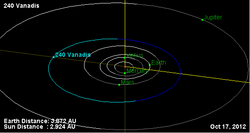Astronomy:240 Vanadis
 Orbital diagram | |
| Discovery | |
|---|---|
| Discovered by | A. Borrelly |
| Discovery date | 27 August 1884 |
| Designations | |
| (240) Vanadis | |
| Pronunciation | /ˈvɑːnə.dɪs/ |
| Named after | Freyja |
| A884 QB | |
| Minor planet category | Main belt |
| Orbital characteristics[1] | |
| Epoch 31 July 2016 (JD 2457600.5) | |
| Uncertainty parameter 0 | |
| Observation arc | 131.61 yr (48072 d) |
| |{{{apsis}}}|helion}} | 3.2134 astronomical unit|AU (480.72 Gm) |
| |{{{apsis}}}|helion}} | 2.1178 AU (316.82 Gm) |
| 2.6656 AU (398.77 Gm) | |
| Eccentricity | 0.20551 |
| Orbital period | 4.35 yr (1,589.6 d) |
| Average Orbital speed | 18.25 km/s |
| Mean anomaly | 60.5202° |
| Mean motion | 0° 13m 35.292s / day |
| Inclination | 2.1043° |
| Longitude of ascending node | 115.191° |
| 300.174° | |
| Physical characteristics | |
| Dimensions | 103.90±2.5 km[1] 94.03±5.37 km[2] |
| Mass | (1.10 ± 0.92) × 1018 kg[2] |
| Mean density | 2.53±2.15 g/cm3[2] |
| Rotation period | 10.64 h (0.443 d) |
| Geometric albedo | 0.0411±0.002 |
| C | |
| Absolute magnitude (H) | 9.00 |
Vanadis (minor planet designation: 240 Vanadis) is a fairly large main-belt asteroid with a diameter of around 100 km. It was discovered by A. Borrelly on August 27, 1884, in Marseilles and was named after Freyja (Vanadis), the Norse fertility goddess. The asteroid is orbiting the Sun at a distance of 2.67 astronomical unit|AU with a period of 4.35 yr and an orbital eccentricity of 0.206. The orbital plane is inclined at an angle of 2.10° to the plane of the ecliptic.[1]
Photometric observations of the asteroid made during 2022 were used to produce a light curve that showed a rotation period of 10.565±0.002 h with a brightness variation of 0.07±0.01 in magnitude. This is consistent with earlier estimates.[3] It is very dark and is classified as a C-type asteroid, probably composed of primitive carbonaceous material.
References
- ↑ 1.0 1.1 1.2 "240 Vanadis". JPL Small-Body Database. NASA/Jet Propulsion Laboratory. https://ssd.jpl.nasa.gov/sbdb.cgi?sstr=240;cad=1.
- ↑ 2.0 2.1 2.2 Carry, B. (December 2012), "Density of asteroids", Planetary and Space Science 73: pp. 98–118, doi:10.1016/j.pss.2012.03.009, Bibcode: 2012P&SS...73...98C. See Table 1.
- ↑ Pilcher, Frederick (October 2022), "Lightcurves and Rotation Periods of 233 Asterope, 240 Vanadis, 275 Sapientia, 282 Clorinde, 414 Liriope, and 542 Susanna", Bulletin of the Minor Planets Section of the Association of Lunar and Planetary Observers 49 (4): 346–349, Bibcode: 2022MPBu...49..346P.
External links
- The Asteroid Orbital Elements Database
- Minor Planet Discovery Circumstances
- Asteroid Lightcurve Data File
- 240 Vanadis at AstDyS-2, Asteroids—Dynamic Site
- 240 Vanadis at the JPL Small-Body Database
 |

